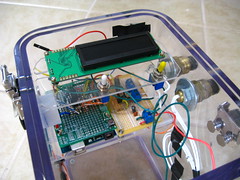Tuesday, November 29, 2011
Monday, October 3, 2011
Wednesday, February 23, 2011
Erratic sensor readings
As always someone has seen this before and on the adafruit forum there is a write up about interferences
Solution to try:
The problem is that the Atmega on the Arduino has one ADC that is multiplexed for all the analog pins.
When you do an analogRead(), a multiplexer connects the pin you are reading to the ADC. This works fine for low impedance voltage sources.
It takes time for a high impedance sensor like your temperature sensor to change the voltage at the ADC after this switch of pins. Temperature sensors must use low power and thus be high impedance to avoid IR heating.
Try the following:
The first analogRead(5) will switch the pin to the ADC. The delay will allow the voltage at the ADC to stabilize and the second analogRead(5) should get a stable value.
As a note: Tuesday, February 22, 2011
Adafruit datalogger shield

Sunday, February 20, 2011
Xbee remote sensor station

Thursday, February 17, 2011
Handling exceptions in processing
Saturday, January 22, 2011
SDI-12 to arduino

Control panel for DO datalogger
Originally uploaded by whirlymark
Interfacing SDI-12 to arduino means converting SDI-12 to arduino or serial 232 input. Using a converter like the WaterLog H-4191 would work and LABView have some ideas on SD-12 usage. If the arduino used a MAX 232 chip or Sparkfun version to convert to 232 or the MaxSerial arduino from Freeduino
Better to use the %V and convert to TTL but SDI-12 is one wire for TX and RX. Ideas at AVR forum, with their final thoughts being
So I guess your best option is 3 LL parts, 2 inverters and one buffer with an output enable.
Ok here is my final solution for you, this combo should work.
Dual inverter for TX/RX: SN74LVC2GU04 running at 3.3V (5V tolerant inputs) which can be converted to DIP using SOT23 to DIP Adapter sku: BOB-00717 from Sparkfun
Tristate Buffer for Tx: SN74AHCT1G126 running at 5V (Vih min is 2V, so 3V3 logic should drive it fine) which can be converted to DIP using SOT23 to DIP Adapter sku: BOB-00717 from Sparkfun
That dual is nice, also. Running at 3.3V, the Tx inverter outputs 0/3.3V which is acceptable by the tristate buffer so its function is inversion, only. On the Rx side, the input is 5V tolerant, so it behaves well receiving on the SDI-12 bus. It is also $0.40 in quantity of 1 and $0.11 @ 3K from DigiKey. So, it won't break the bank.
Alternative solution: Now my solution was to use the ADG3304 bi-directional voltage level shifting IC to also provide 5V logic level enables for the tri-state buffer, as well as logic shifting for the RX/TX
On-line temperature sensor site

Monday, January 17, 2011
Hackerspace Syracuse
- Jan 20 @ 6pm
- Location
- Syracuse Innovators Guild
224 Harrison St
Syracuse, NY 13202How to find us
"Suite 214, and if the outer door locks because you arrive a little late call me at [masked] and I'll let you in."
Thursday, January 13, 2011
Monitor temperatures remotely

Read a thermometer on-line using an arduino and an ethernet board, and also Tom Igoe used an ethernet shield to upload data to Pachube, and also in the arduino library
Sparkfun has a great enclosure for an ethernet shield on an arduino and there is an interesting site about using a smart Phone to control it all.

